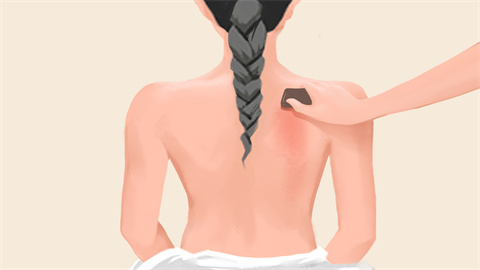Why do pimples appear after scraping the back?
Generally speaking, pimples refer to acne. Possible causes of acne after back scraping (Gua Sha) may include temporary damage to the skin barrier, a reaction to the elimination of metabolic waste, folliculitis, seborrheic dermatitis, or contact dermatitis. If discomfort occurs, prompt medical attention is recommended. Detailed explanations are as follows:

1. Temporary Damage to the Skin Barrier
Friction from the Gua Sha tool during scraping may cause slight damage to the skin's epidermis and increase pore permeability. If not cleaned promptly, sebum or dirt may accumulate and lead to pimples. It is advisable to stop Gua Sha, clean the area with warm water, apply a gentle moisturizing lotion, and avoid further irritation or friction.
2. Reaction to Metabolic Waste Discharge
Gua Sha promotes local blood circulation and accelerates the elimination of metabolic waste from the body. In some individuals, this process may temporarily manifest as pimples on the skin. These pimples usually do not present with redness or pain and typically resolve spontaneously within 1–2 weeks. Keeping the skin dry and clean during this period is recommended.
3. Folliculitis
Folliculitis may occur due to improper pressure or unhygienic practices during Gua Sha. Once hair follicles are damaged, bacteria can easily invade and cause inflammation, presenting as red, swollen acne, which may be accompanied by increased local skin temperature, pain, or pus formation. Under a doctor's guidance, topical antibiotics such as mupirocin ointment, fusidic acid cream, or erythromycin ointment may be used for anti-infective treatment.
4. Seborrheic Dermatitis
In individuals with abnormal sebum secretion, Gua Sha may trigger or exacerbate inflammation, manifesting as papules on a background of erythema, accompanied by oily scales. Patients may, under medical guidance, use ketoconazole shampoo to clean the affected area 2–3 times per week and apply mild topical corticosteroid creams such as desonide cream to alleviate inflammation.
5. Contact Dermatitis
Allergic reactions to Gua Sha oil, lubricants, or the material of the scraping tool may trigger inflammatory responses, presenting as clusters of red papules or vesicles, often accompanied by itching or a burning sensation. The rash typically has clear borders corresponding to the area of contact. The suspected allergen should be discontinued immediately, and treatment under medical advice may include antihistamine medications such as cetirizine hydrochloride tablets, loratadine tablets, or chlorpheniramine maleate tablets.
To help prevent this condition, it is recommended to ensure that Gua Sha instruments are clean, free of allergens, and appropriately disinfected before use. Additionally, regular moderate exercise and a balanced diet can help reduce internal dampness accumulation and sebum secretion, thereby lowering the risk of developing acne.







